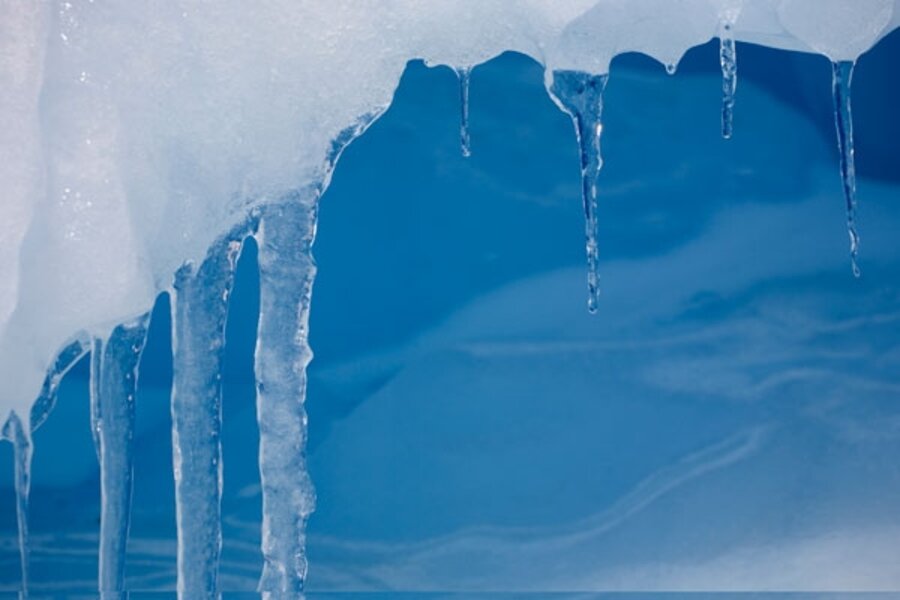New study: Less sea rise expected from possible Antarctic melt
Loading...
The ice sheet sitting atop Antarctica is so vast, up to 3 miles (5 km) thick in some places, that it pushes earth’s crust thousands of feet down. If all that ice melted, it would raise sea levels globally by an estimated 230 feet (70 meters).
No one thinks that Antarctica will thaw completely anytime soon, of course, but scientists are increasingly worried by changes observed in just one area: the West Antarctic Ice Sheet (WAIS).
Until recently, scientists estimated that if the WAIS melted, sea levels worldwide would rise by some 16 feet. Now, using more refined data, a new study in the May 15 issue of the journal Science revises that number down to an average 11-foot sea level rise.
For decades, scientists have observed that while the Antarctica’s interior appears to have cooled, the outer regions — specifically the Antarctic Peninsula — have warmed. They attribute the changes to stronger circumpolar winds — and the fiercer winds, ultimately, to human impact on weather.
Shifting wildlife seems to corroborate the observed changes. Colder-climate penguins have retreated southward on the peninsula; species adapted to relatively warmer climes have advanced. Concentrations of clear, cold water-loving phytoplankton, the basis of the Antarctic food chain, have also pushed Poleward.
In January, scientists writing in Science argued that the warming extended beyond just the peninsula, and included the WAIS. That has alarming implications, they say. The WAIS rests on bedrock that's partly below sea level. As a result, scientists think that it's sensitive to changes in ocean temperature, and maybe prone to rapid melting.
Indeed, two studies reported in Nature in March conclude that the ice sheet has melted (and reformed) in the past relatively quickly. Several times between 3 and 5 million years ago, when temperatures were around 3 degrees C (5.4 degrees F.) higher than today and atmospheric CO2 was at 400 ppm, just above where we are now, the WAIS was a shallow sea.
What does this mean for the two-thirds of humanity inhabiting coastal areas?
Previously, scientists estimated how much the WAIS would contribute to global sea level rise by taking the total amount of water frozen as ice and spreading it around the globe evenly. That meant a 16-foot sea level rise worldwide.
But a study published earlier this year in the Science complicated that picture. The older calculations hadn't included the following important factors, wrote the authors:
1. The WAIS is so massive that it exerts a gravitational pull on the surrounding water. If it disappears, so does that pull. Nearby water, released from the gravity, will flow away. Regions farther away — like the Northern Hemisphere — will see an influx. The subsequent sea level rise there would be greater than what one might think by evenly spreading the WAIS's meltwater around the globe.
2. If the glacier disappears, the Earth’s crust, now depressed, will bounce back — what scientists call “isostatic rebound.” The rising bedrock would counteract sea level rise in the immediate region, and also push water elsewhere.
3. Finally, the WAIS’s disappearance could change the location of Earth’s rotational axis by some 500 meters (1600 feet). That, in turn, affects how and where water accumulates in the world’s oceans.
All in all, the authors estimated that some parts of the world would experience sea-level rises 25 percent greater than previous estimates suggested. Rather than a 16-foot increase, for example, Washington, D.C., might find its seas 21 feet higher.
But the new study says that sea level rise actually will be much lower. The authors of this study also account for gravity, centrifugal force, and planetary elasticity. But they use more refined information on how much of the WAIS, exactly, is prone to melting.
"There are parts of the ice sheet which remain grounded and look relatively stable," says Jonathan Bamber, a professor of physical geography at England's University of Bristol and lead author on the study. "We're saying that about one-third looks like it survives, or that it's not vulnerable to this instability."
If what can melt does, seas will rise 11 feet on average, not 16, they say. But as in the previous study, the authors find that the east and west coasts of North America will see some of the greatest increases — perhaps 13 feet.
Editor's note: Monitor science writer Pete Spotts will be blogging on this topic later today and when that's posted, we will give the URL here. [It's up now; click here.] He will have some interesting background on this information. Also he will write about some additional work on rising seas caused by melting ice that coming up for publication, which will be specific to the northeastern United States. "Turns out that if Greenland melts," Pete says, "the rise here [in the Northeast] is likely to be higher than average because of changes all that freshwater would bring to ocean circulation."





